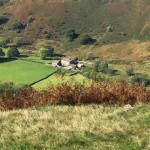
Credit: Brenda Barrett
At every level conservation practioners labor to understand and balance natural and cultural values at a landscape scale. Globally, this challenge plays out in the push and pull of the World Heritage inscription process. When in 1972 UNESCO adopted the Convention Concerning the Protection of the World Cultural and Natural Heritage, referred to as the World Heritage Convention, the document recognized the importance of both natural and cultural heritage. However, these values were generally treated in a parallel manner. To be inscribed on the World Heritage list a site must be of Outstanding Universal Value and meet at least one of the ten selection criteria. of which six are focused on cultural resources and the other four on natural resources. Most sites are nominated under either the cultural or the natural criteria. While sites can be nominated as mixed site by qualifying independently for the cultural and for the natural criteria, this is not common. To date only 35 sites out of over one thousand World Heritage listings are classified as mixed properties. The fact that two separate organizations, ICOMOS for cultural resources and IUCN for natural resources, are responsible for the development of operational guidelines and technical assistance for proposed World Heritage nominations has further reinforced the bifurcation of the program. However, recently there has been a surge in interest in viewing sites more holistically motivated in part by the recognition that global issues such as climate change, population shifts and urbanization, and political instability threaten all resources. This has resulted in renewed efforts to bridge the culture- nature divide and seek more universal solutions.

Credit: Brenda Barrett
The recent (July 2017) inscription by the World Heritage Committee of the English Lake District highlights some of the challenges and opportunities of integrating cultural and natural values. Located in northwest England, the English Lake District represents the combined work of nature and human activity, which produced a harmonious landscape in which the mountains are mirrored in the lakes; a region whose valleys were carved by ice age glaciers and then shaped by centuries of agro-pastoral land use; a landscape that has been appreciated from the 18th century onwards by the Picturesque and later Romantic movements, which has been celebrated in paintings, drawings and words. It also has inspired an awareness of the importance of beautiful places and triggered early efforts to preserve them for future generations.
This is a celebrated and iconic landscape, but there have been bumps on the road to gaining World Heritage recognition. The English Lake District was first nominated in 1986 as a mixed site proposed under both the cultural and natural criteria. However, in 1987 the World Heritage Committee was not convinced by this approach and decided to leave open its decision on the nomination until it had further clarified the committee’s position regarding the inscription of cultural landscapes. Two years later the state party then submitted the nomination under cultural criteria alone and while the nomination was discussed again at the World Heritage in 1990, there was still no resolution on how to address a site best described as a cultural landscape.

Credit: Brenda Barrett
The idea of a cultural landscapes category within the World Heritage Convention first began to emerge in the 1980s, as the committee debated the issue of how to recognize landscapes that included both cultural and natural resources. This debate was spurred in part by the saga of the United Kingdom’s unsuccessful nomination of the Lake District, as a natural and then as a cultural site, and also by uncertainty among many committee members about the relationship between the idea of a lived-in landscape and the concept of a Mixed Sites. It was fitting that in October 1987 an international expert symposium was convened in the Lake District National Park to examine these issues. The outcome was the Lake District Declaration, the opening lines of which are echoed in the current Lake District nomination, “People in harmonious interaction with nature, have in many parts of the world fashioned landscapes of outstanding value, beauty and interest.”
The Lake District Declaration made many recommendations to improve the management and understanding of protected landscapes. Since that time much progress has been made by the World Heritage Committee in refining the criteria and operational guidelines to better define cultural landscapes as:
47: Cultural landscapes are cultural properties and represent “combined works of nature and of man” designated in Article 1 of the Convention. They are illustrative of the evolution of human society and settlement over time, under the influence of the physical constraints and/or opportunities presented by their natural environment and of successive social, economic and cultural forces, both external and internal.

Credit: Brenda Barrett
Applying these criteria in 2016, the United Kingdom prepared a new nomination for the English Lake District as a cultural landscape based solely on World Heritage cultural criteria (ii), (v) and (vi). While IUCN did not participate in the technical evaluation of the Lake District nomination, it did provide comments from a natural resource perspective to the World Heritage Committee. (See IUCN World Heritage Evaluation 2017) IUCN’s comments noted that quarrying within the boundaries of the nominated property was a matter of concern for its impact on the region’s flora and fauna. Also the IUCN report raised the issue of providing a buffer zone or additional planning strategies to protect the property from climate change and over development. Its comments also stated that the English Lake District played an important role in the development of IUCN Category V resources – protected landscape/seascape. These resources are defined as a protected area where the interaction of people and nature over time has produced an area of distinct character with significant ecological, biological, cultural and scenic value: and where safeguarding the integrity of this interaction is vital to protecting and sustaining the area and its associated nature conservation and other values

Credit: Brenda Barrett
The English Lake District is often cited in the literature on protected areas as the classic example of a Category V landscape and has provided the basis for the application of the concept in other parts of the world. While the IUCN comments on the recent nomination suggested that this connection should be more strongly emphasized, the comments did not follow on and provide guidance on one of the most pressing culture/nature issues facing the region. The challenge, which is explicitly stated in the nomination, is how to sustain the 200 or so shepherding families and their flocks of hefted Herdwick sheep that have been instrumental in creating much of the special character of the landscape and are indispensable to maintaining many of its defining features. The traditional shepherding way of life is threatened by global market forces that impact the viability of farming communities and in the United Kingdom national agricultural plans and subsidies face additional uncertainty in a post Brexit world. And if this is not enough, shepherding as a way of life in the Lake District is also threatened by some nature conservation policies that promote a different vision for the region: A vision that encourages the re-wilding of the landscape. The most out spoken critics of the traditional shepherding practices describe the Lake District as a “sheep-wrecked landscape”. The bid for World Heritage designation has been criticized as discouraging other efforts to re-introduce a great variety of plants and wildlife in favor of the status quo.
In considering the nomination, ICOMOS recognized the value of this agro-pastoral landscape. ICOMOS also made specific recommendations to the World Heritage Committee to address the long term survival of this way of life – recommending national farm supports to assist shepherding community in maintaining the heritage values of the landscape as well assistance in preserving the genetic diversity of the herds and their role in providing for the nation’s future food security. In addition the report recommended rebalancing public funding for preserving natural resources in the region to provide support for conserving its cultural landscape. This is good stuff. But it would have had even more power if IUCN had weighed in using the principles articulated for Category V Landscapes including one of the primary objectives for these places: To maintain a balanced interaction of nature and culture through the protection of landscape and/or seascape and associated traditional management approaches, societies, cultures and spiritual values.
If ICOMOS and IUCN had presented unified recommendations in this matter using both the cultural landscape approach and the principles of Category V landscapes, the Lake District nomination could have provided future guidance on how to balance natural and cultural values in this lived in landscapes. It could have provided an additional chapter in the English Lake District’s long journey to World Heritage listing.
Postscript
For the conservation community the successful nomination of the English Lake District is only one more step on the Nature/Culture Journey. At the IUCN sponsored 2016 World Conservation Congress in Hawaii a special track featuring over 50 related sessions brought together the Nature and Cultural community to look at interrelated ecological and cultural topics – often across large landscapes – to better understand the field’s complementary knowledge and capacities. This will be followed by a complementary Culture/Nature Journey at the upcoming Scientific Symposium at the ICOMOS General Assembly meeting in Delhi India in December 2017.
IUCN and ICOMOS have also launched the Connecting Practice initiative devised and implemented by “to explore, learn and create new methods that are centered on recognizing and supporting the interconnected … character of the natural, cultural and social values of highly significant landscapes and seascapes”. The goal of this practice led approach is to deliver a fully connected approach to considering nature and culture in the context of World Heritage. A number of pilot studies to test this strategy of learning while doing have undertaken in Mongolia, Hungary and South Africa. Read the just released report on Connecting Practice



